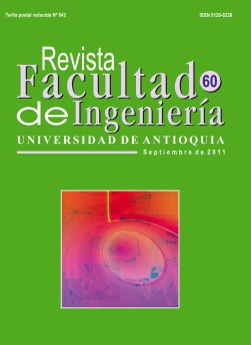A novel graphical and analytical method for the kinematic analysis of fourth class Assur groups
DOI:
https://doi.org/10.17533/udea.redin.13660Keywords:
fourth class Assur group, structural analysis, kinematic analysisAbstract
A method for the kinematic analysis of a fourth class Assur group, using a combination of graphical and analytical methods, is presented in this paper. The solution is obtained through a method in which two special Assur points are used. A mechanism of 1 DOF with a fourth class group is considered as an example to develop the proposed method. The results of this method are in agreement with the results obtained by a dynamic simulation program. Since there are no solutions for fourth class structural groups in the literature,this method allows developing a complete modular procedure for the kinematic analysis of mechanisms, with the methodological advantages that this type of solution offers.
Downloads
References
I. I. Artobolevski. Theory of Mechanisms and Machines. Ed.Nauka. Moscow. Russian. 1988. pp. 52-63.
P. Fanghella, C. Galleti, “A modular method for computational kinematics”. Computational Kinematics. J. Angeles, G. Hommel and P. Kovacs (editors). Ed. Kluwer. Dordrecht. 1993. pp. 275-284. DOI: https://doi.org/10.1007/978-94-015-8192-9_25
G. Calle, A. Diaz, H. F. Quintero. Análisis cinemático de mecanismos planos a partir del análisis estructural según Assur. V Congreso Iberoamericano de Ingeniería Mecánica. Merida. Venezuela. Octubre 23-26. 2001. pp. 1231-1240.
S. Mitsi, K. D. Bouzakis, G. Mansour. “Position analysis in polynomial form of planar mechanism with an Assur group of class 4 including one prismatic joint”. Mech. and Mach. Theory. Vol. 39. 2004. pp. 237-245. DOI: https://doi.org/10.1016/S0094-114X(03)00115-0
W. Y. Cheng. “The position analysis of Assur kinematic chain with five links”. Mech. and Mach. Theory. Vol. 40. 2005. pp. 1015-1029. DOI: https://doi.org/10.1016/j.mechmachtheory.2004.12.016
S. Mitsi, K. D. Bouzakis, G. Mansour, I. Popescu. “Position analysis in polynomial form of class-three Assur”. Mech. and Mach. Theory. Vol. 43. 2008. pp. 1401-1415. DOI: https://doi.org/10.1016/j.mechmachtheory.2007.12.001
K. Romaniak. Methodology of the Assur Groups Creation. 12th IFToMM World Congress. Besançon, France. June 18-21. 2007. pp. 1- 5.
G. G. Baránov. Curso de la teoría de Mecanismos y Máquinas. Ed. Mir. Barcelona. 1979. pp. 46-82.
Mashinostroyenye: Enciclopedy in 40 Vols. Dynamic and Strength of machines. Theory of Mechanisms and Machines. Vols. 1-3. Book 2. Ed. Mashinostroyenye. Moscú. 1995. pp. 415-417.
R. Brock, H. Dresig, C. Hammerschmidt, B. Hüther, E. Huhn, W. Ihme, P. Jacobi, G. Jokisch, W. Müller, M. Schulze, G. Thiel. “Kinematische Analyse ebener Mechanismen”. Getriebetechnik Lehrbuch. J. Volmer. (editor). 1ª ed. Ed. Verl Technik. Berlin. 1987. pp. 166-168.
J. Buskiewicz. “A method of optimization of solving a kinematic problem with the use of structural analysis algorithm (SAM)”. Mech. and Mach. Theory. Vol. 41. 2006. pp. 823-837 DOI: https://doi.org/10.1016/j.mechmachtheory.2005.10.003
L. T. Dvornikov, S. P. Starikov. “Kinematics and kinetostatics of Assur’s flat six-section group of the fourth class”. Mech. and Mach. Theory. Vol. 4. 2006. pp. 61-65.
M. Z. Kolovsky, A. N. Evggrafov, Y. U. Semenov, A. V. Slousch. Advanced Theory of Mechanisms and Machines. Ed. Springer. Berlin. 2000. pp. 79-85 DOI: https://doi.org/10.1007/978-3-540-46516-4_3
Downloads
Published
How to Cite
Issue
Section
License
Copyright (c) 2018 Revista Facultad de Ingeniería

This work is licensed under a Creative Commons Attribution-NonCommercial-ShareAlike 4.0 International License.
Revista Facultad de Ingeniería, Universidad de Antioquia is licensed under the Creative Commons Attribution BY-NC-SA 4.0 license. https://creativecommons.org/licenses/by-nc-sa/4.0/deed.en
You are free to:
Share — copy and redistribute the material in any medium or format
Adapt — remix, transform, and build upon the material
Under the following terms:
Attribution — You must give appropriate credit, provide a link to the license, and indicate if changes were made. You may do so in any reasonable manner, but not in any way that suggests the licensor endorses you or your use.
NonCommercial — You may not use the material for commercial purposes.
ShareAlike — If you remix, transform, or build upon the material, you must distribute your contributions under the same license as the original.
The material published in the journal can be distributed, copied and exhibited by third parties if the respective credits are given to the journal. No commercial benefit can be obtained and derivative works must be under the same license terms as the original work.










 Twitter
Twitter